Boletus L.
Recent molecular studies have shown that Boletus in its current circumscription is likely an artificial grouping and it is possible that it will be split at some point into smaller genera. Note that Boletus impolitus and Boletus depilatus for practical reasons are retained here, although there is strong evidence that they are closely related to Xerocomus subtomentosus and its allies.
Fruitbody large to medium sized, boletoid, without veil and ring. Stipe solid, with surface usually covered with granules or network. Flesh variously coloured, changing or not when exposed to air. Tubes easily separable from each other, not tearing apart. Pores usually small and rounded.
Boletus fechtneri Velen.
Description
Cap up to 20 cm, convex to flat-convex, sometimes almost flat, initially dry, smooth or finely cracked, later sometimes slightly viscid, silvery grey, grey to dark gray or grayish ochraceous, sometimes with pinkish tint at the margin, not blueing when bruised. Stipe clavate or cylindrical, sometimes tapering towards the base or rooting, lemon yellow to yellow, sometimes discolouring in places to pale yellowish, sometimes with pinkish or reddish zone at the middle, at least in the upper half but most often entirely covered with fine network, stipe surface blueing when bruised. Flesh yellowish to yellowish white, in the stipe base pinkish or brownish pink, blueing predominantly in the cap when exposed to air. Tubes initially lemon yellow, then yellow, finally yellow with olivaceous tint, blueing when exposed to air. Pores concolorous, blueing when bruised. Smell not distinctive. Taste not distinctive. Spores 9–15 × 3.5–5.5 μm, ratio 2–3.4. Pileipellis (the cap cuticle) trichodermium of interwoven septate hyphae. Cells of the hyphae cylindrical, finely incrusted. Chemical reactions: hyphae of the flesh in the stipe base inamyloid with Melzer’s solution.
Habitat. Sheltered broadleaf forests, mycorrhizal with oaks (Quercus), beech (Fagus) or sweet chestnut (Castanea sativa), often on calcareous soils.
Distribution. In Europe more or less widespread, but apparently more common in south.
Similarity. Compare with Boletus appendiculatus and B. pseudoregius.
Photographs
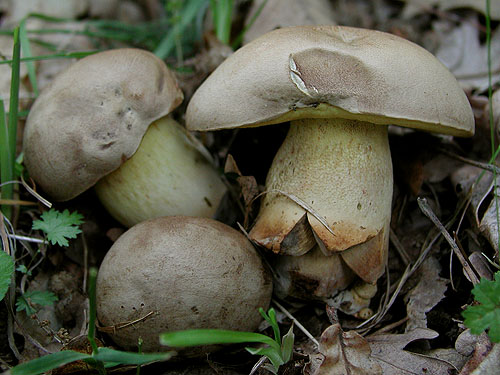
Young fruitbodies of Boletus fechtneri. Note the cap colour. (photo B. Assyov)
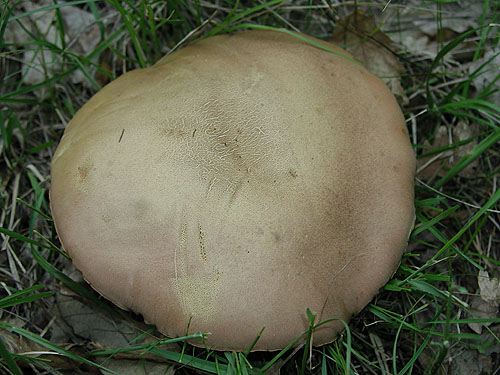
Mature fruitbody of Boletus fechtneri. Note the cap colour. (photo B. Assyov)
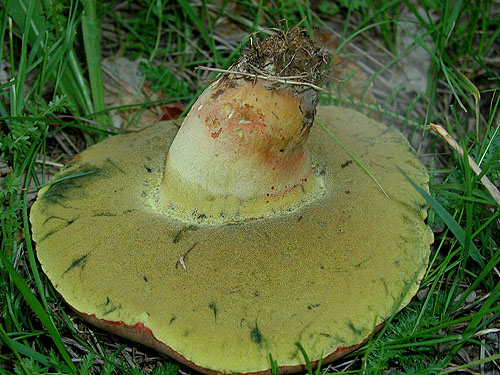
Boletus fechtneri. Note the blueing yellow pores. (photo B. Assyov)
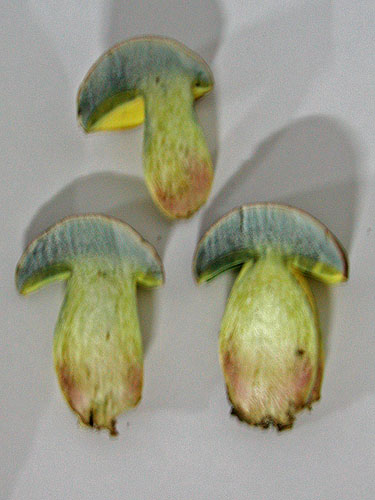
Sections of fruitbodies of Boletus fechtneri. (photo B. Assyov)
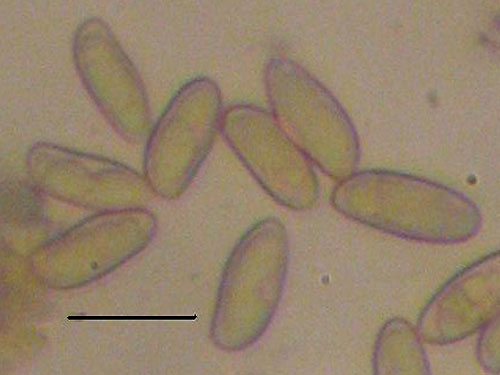
Spores of Boletus fechtneri. Scale bar = 10 μm. (photo B. Assyov)
Important literature
Alessio, C.L. 1985. Boletus Dill. ex L. (sensu lato). – In: Fungi Europaei. Vol. 2. Pp. 1–705. Libreria editrice Biella Giovanna, Saronno.
Assyov, B. (2012). Revision of Boletus section Appendiculati (Boletaceae) in Bulgaria with a key to the Balkan species. – Turkish Journal of Botany 36: 408–419. (available online)
Engel, H., Krieglsteiner, G., Dermek, A. & Watling, R. 1983. Dickröhrlinge. Die Gattung Boletus in Europa. Verlag Heinz Engel, Weidhausen b. Coburg.
Estadès, A. & Lannoy, G. 2004. Les bolets européens. – Bulletin Mycologique et Botanique Dauphiné-Savoie 44(3): 3–79.
Galli, R. 1998. I Boleti. Atlante pratico-monographico per la determinazione dei boleti. Edinatura, Milano.
Knudsen, H. & Vesterholt, J. [eds.]. 2008. Funga Nordica. Nordsvamp, Kopenhagen.
Lannoy, G. & Estadès, A. 2001. Les Bolets. Flore mycologique d’Europe. Documents Mycologiques Mémoire Hors série no. 6. Pp. 1–163. Association d’Écologie et de Mycologie, Lille.
Marques, G. & Muñoz, J.A. 2006. Révision des espèces européennes du genre Boletus section Appendiculati. Étude sur la base de caracteres morphologique et d’analyse des polymorphismes des fragments de restriction (PCR-RFLP). – Bulletin Trimestriel de la Société Mycologique de France 122: 353–366.
Muñoz, J.A. 2005. Boletus s. l. – In: Fungi Europaei. Vol. 1. Pp. 1–951. Edizioni Candusso, Alassio.
Pilát, A. & Dermek, A. 1974. Hríbovité huby. Československé hríbovité a sliziakovité huby (Boletaceae – Gomphidiaceae). Veda, Bratislava.
Singer, R. 1967. Die Röhrlinge. II. Die Boletoideae und Strobilomycetaceae. – In: Die Pilze Mitteleuropas. Vol. 6. Pp. 1–151. Julius Klinkhardt Verlag, Bad Heilbrunn.
Šutara, J., Mikšík, M. & Janda, V. 2009. Hřibovité houby. Čeled’ Boletaceae a rody Gyrodon, Gyroporus, Boletinus a Suillus. Academia, Praha.
Velenovský, J. 1922. České houby. Vol. 4/5. Nákladem České botanické společnosti, Praha. (available online)